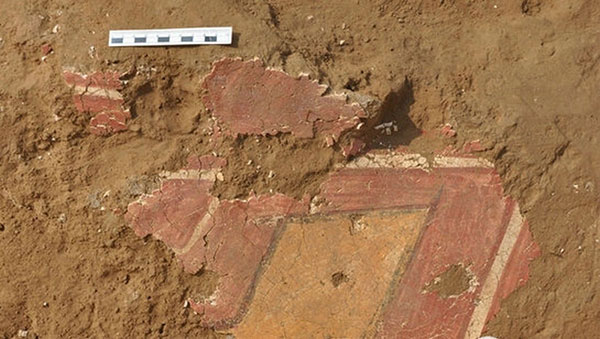 |
| A close-up photo shows a piece of a mural. [Photo/chinadaily.com.cn] |
A group of recently-discovered murals
hinted that the basic production process and rendering techniques used
to make Chinese murals might be more than 4,000 years old. Since 2011,
continuous excavations by Chinese archaeologists have found some 200
pieces of colorful murals in the Shimao Ruins, the largest completed
urban construction in China dating from the late Neolithic (4,600 -
4,000 years ago) age in Shenmu county, Shaanxi province.
The Shaanxi Provincial Institute of
Archaeology recently issued a report on the discovery, saying that
following lab experiments and analysis, the basic production process and
rendering techniques used on the murals in Shimao Ruin were similar to
those used to make frescoes dating from the Han Dynasty (202 BC – 220
AD) and later dynasties. This indicates that the process and techniques
were in use more than 4,000 years ago.
Archaeologists found traces of pigment
layers on a mural that indicates brush-like tools were used to make the
mural, even though the brush is considered to have been invented by Meng
Tian, a general in the Qin Dynasty (221 – 207 BC).
"The history of using the brush by
Chinese people will be rewritten if the tool used to make the mural is
confirmed to be a brush," experts said.
The experts also noted that the types of
pigments used for the murals were made of glauconite, which was found
in the sea, but the Shimao Ruin is located on the Loess Plateau far from
the sea.
"The source of the pigment is also a concerned matter for further research," experts said.
According to the historical record,
Chinese murals were used to decorate houses from early on and used for
tombs as early as the Western Zhou Dynasty (1046 – 771 BC). The murals
were found mainly in North China, which indicates that the region was
the birthplace of the Chinese mural, experts said. china.org.cn/
Actualización 26-08-15: Marcas de pinceladas descubiertas en pinturas murales podrían reescribir la historia del arte en China | Ancient Origins
Recientes descubrimientos realizados en las ruinas de una ciudad prehistórica podrían reescribir la historia del arte en China. Los arqueólogos que se encuentran trabajando en las ruinas del yacimiento Neolítico de Shimao, han identificado fragmentos de pinturas murales que muestran posibles marcas de brocha o pinceladas, lo que podría significar que el procedimiento básico de realización de pinturas murales en China se remonta a hace unos 4.000 años. Los historiadores generalmente atribuyen la invención del pincel al general Meng Tian en una época mucho más tardía, durante la dinastía Qin, que va del 221 a. C. al 207 a. C.
Los expertos que se encuentran estudiando los restos del mural han observado lo que describen como marcas en las capas de pigmento, semejantes a las que dejarían una brocha o pincel al ser utilizados. Por otro lado, también resulta interesante el hecho de que algunos de los pigmentos incluyan en su composición glauconita, un mineral que procede de zonas costeras de China. Sin embargo, las ruinas de Shimao se encuentran en la Meseta de Loess, muchos kilómetros tierra dentro...
Entrada relacionada (2012)
Entrada relacionada (2012)








1 comentario:
Actualización: Marcas de pinceladas descubiertas en pinturas murales podrían reescribir la historia del arte en China
Publicar un comentario